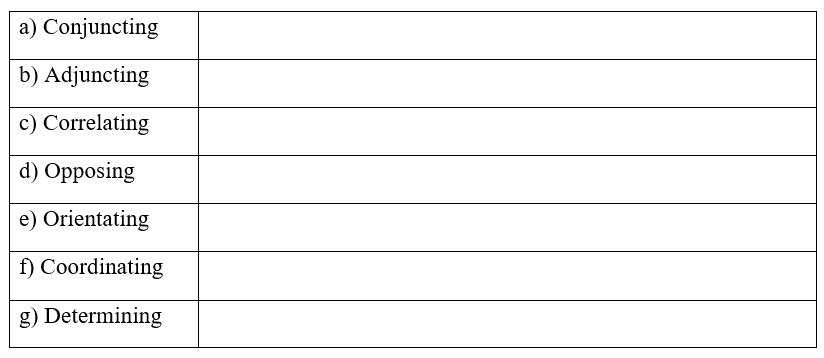Academic Writing: Linking paragraphs together
Each new paragraph begins with a phrase that links it to the previous paragraph, in order to maintain continuity of argument:
· Despite this (i.e. the lack of a conclusive link)…
· All these claims (i.e. arguments in favour of the previous idea)…
In order to begin a new topic, you may use:
· Turning to the issue of . . .
· Some (points,elements,arguments…) must also be examined . . .
· . . . is another area for consideration
Paragraphs can also be introduced with adverbs:
· Traditionally, few examples were . . .
· Finally, the performance of . . .
The following expressions make up links and connectors accounting for:
a) Conjuncting
b) Adjuncting
c) Correlating
d) Opposing
e) Orientating
f) Coordinating
g) Determining
Put these phrases under a corresponding title:
ahead, against, in order to, though, regardless, unless, concerning, notwithstanding; but, if, hence, since, rather than, namely, that is, above/ after all, aside, besides, according to, consequently, furthermore, according/ due to, because, nevertheless, regarding, respectively, with, without away, as well, counter, whether, only, versus, next, now, vice versa, otherwise, whereas, aside, back, backward, behind, neither, against, between, here, to trans-, under, up, upon, via, where, within, therefore, which,despite,after, still, while, as yet , such, with respect to, each, other, the same, something, what, , whose, why, thereby.
Analyze the following paragraph and say what linking phrases are used to maintain continuity of argument:
CONTROL-ORIENTED COMPENSATION
A capacitance calculation method is proposed in [12]. Unlike the method presented in II.C, it is an interesting way to compensate the reactive part of the transformer by solving (9) to (12), and therefore finding the compensation capacitances independently from the transformer’s parameters. This methodology is mostly relevant for cases where the design of the primary part (inverter) and the one of the secondary part (battery charger) are not provided by the same developers. This leads to a higher inter-operability between the components, as partial derivatives of Ci are minimized.
Developers of the primary side may propose solutions that are less sensitive to secondary components or variations that may appear such as aging or regular parameter variations. This methodology is called “Control-oriented compensation (COC)”. Results are presented in TABLE III. No differences appear for the two primary serial compensation topologies. On the contrary, regarding the primary parallel compensations, one can notice that for PS compensation, C1 expression no longer depends on the load resistance RL (battery state effect, see II.B, Eq. (2) ), nor on the mutual inductance M (coupling effect) and C2 is less coupling-dependent.
For the PP compensation, only C1 is load-independent and coupling less dependent. The following example, extracted from [12], shows the robustness of the method: The WPT is first tuned using the EOC and then the COC methods, while having a medium load (RL = 30 Ω). For both cases, the load is then increased to a higher load (RL = 4 Ω). On Fig. 12, one can see the new waveform of the inverter voltage in both EOC and COC cases.
The COC method leads to no change of the waveform that remains a rectified sine wave (no detuning). As main criterion of the COC is no longer efficiency, the transformer's primary current increases in an expected manner. The phenomenon is true only for low load resistance values (high power). It is illustrated on Fig. 13 calculation results. Although the COC method tends to increase the primary current at high load, the output power is also increased (Fig. 14) resulting in a limited loss of overall efficiency (Fig. 15). A key point is to verify that the efficiency is not decreased using the methodology.
One can notice a loss of a few percent with the COC method but only for a high load current and in case of relative high coupling. Electric vehicle inductive charging devices often feature high air-gaps and therefore low coupling factors leading to very low efficiency drop.
In addition to the benefits the method can bring to criteria of Section II.C, it may be interesting also for those of Section II.D as shielding may vary from different carmakers and from EMC local regulations. Indeed, shielding directly affects the internal parameters of the transformer: Eddy currents affect the mutual inductance M on the one hand. Iron losses change the load resistance RL on the other hand. Having a device insensitive to such variations may bring other benefits.

